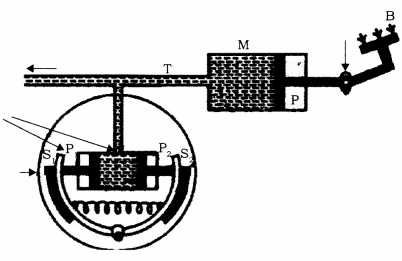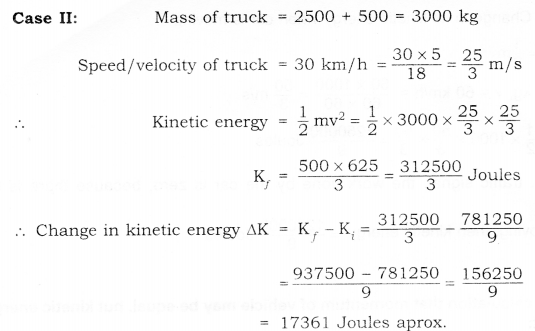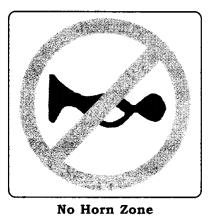RBSE Solutions for Class 9 Science Chapter 16 Road Safety Education are part of RBSE Solutions for Class 9 Science. Here we have given Rajasthan Board RBSE Class 9 Science Chapter 16 Road Safety Education.
| Board | RBSE |
| Textbook | SIERT, Rajasthan |
| Class | Class 9 |
| Subject | Science |
| Chapter | Chapter 16 |
| Chapter Name | Road Safety Education |
| Number of Questions Solved | 20 |
| Category | RBSE Solutions |
Rajasthan Board RBSE Class 9 Science Chapter 16 Road Safety Education
Road Safety Education Textbook Questions Solved
Question 1.
Why there is more chance of an accident during over speed compare to slow speed?
Answer
During over speed, a driver loses the control on the vehicle and due to flurry/confusion, accidents can take places.
Question 2.
A heavy truck and car, both are moving with same speed and after a mutual head-on collision, they come to rest. If the rate of change of momentum is the same for both of them, then why there is more damage to the car in comparison to the truck?
Answer
Momentum p = mu
\(and\quad K.E(K)=\cfrac { 1 }{ 2 } m{ u }^{ 2 }\Longrightarrow k=\cfrac { 1 }{ 2 } .\cfrac { (m{ u) }^{ 2 } }{ m } =K=\cfrac { 1 }{ 2 } \cfrac { { p }^{ 2 } }{ m } \)
[Rate of change of momentum i.e. p is the same for both truck as well as car =)Ka
Car will have more K.E and thus, suffer more damage.
Question 3.
Why F – I car race tracks are specially designed?
Answer
F – I car race tracks are specially designed, so that driver can control on distance, stopping distance and on reaction time.
Question 4.
Observe the vehicle moving ahead of you. When it crosses the stationary object like a tree, pole etc., then count the time (in seconds taken by you to cross the objects. If you reach before, then decrease the speed and if you reach after, then increase the speed. By which instrument will you count the seconds?
Answer
With the help of stopwatch, one can count the seconds.
Question 5.
Complete the following table:
| Speed in km/h | Total stopping distance |
Reaction distance in (m) | Following distance time |
| 30 | 18 | 9 | 2 |
| 60 | 54 | – | 3 |
| 90 | 27 | 4 |
How these distances vary on wet road?
Answer
| Speed in km/h | Total stopping distance | Reaction distance in (m) | Following distance time |
| 30 | 18 | 9 | 2 |
| 60 | 54 | 18 | 3 |
| 90 | 108 | 27 | 4 |
In second situation,
Total stopping distance = Reaction distance x following distance time
\(54=x\times 3\Longrightarrow x=\cfrac { 54 }{ 3 } =18m \)
In the third situation,
Total stopping distance = 27 x 4 = 108 m
On wet road, the reaction distance will increase.
Road Safety Education Additional Question Solved
Question 1.
On which factors, stopping distance depends?
Answer
Stopping distance depends on the following factors:
- Condition of roads
- Weather
- The condition of tyres and breaks of the vehicle.
Question 2.
The acceleration of a racing bike is 8 m/sr>. Find the distance covered by it after 15 seconds, from the starting point.
Answer
We are given that
Initial velocity (u) =O
Acceleration (a) = 8 m/s2
Time (t) = 15 sec
s = ?
s= ut + \(\cfrac { 54 }{ 3 } \) at2 = 0x15 +\(\cfrac { 54 }{ 3 } \) x 8 x 15 x 15
= 4 x 15 x 15 = 900 m
Road Safety Education Textbook Questions Solved
Question 1.
Why threads are made on Tyres?
Answer
Treads are made on the upper surface of the tyre, to increase the friction between road and tyres. Due to this, the vehicle does not slip.
Question 2.
Why there are different threads on a different type of tyres. How they are helpful, in case of accidents.
Answer
Different treads produce a different type of friction and hence, helpful in preventing slipping of cars, during accidents.
Question 3.
Why air in tyres should neither be excessive nor be less than fixed range?
Answer
If the air in tyres is more than the fixed range then tyres burst out, due to large air pressure. On the other hand, if air pressure is low then the actual range than either the consumption of petrol/ diesel will be more, or there is a possibility of a puncture in the tube.
Question 4.
Why we use fuel oil in vehicles?
Answer
Engine is operated by fuel oil. Engine oil converts chemical energy into mechanical energy.
Question 5.
When a vehicle collides with a stationary object, then vehicle jumps backwards. Why?
Answer
When a vehicle collides with a stationary object of identical mass, then stationary object enqounters the great collision force, due to which the vehicle jumps backwards.
Question 6.
During the collision of a truck and a car, on which body more force works? Explain your answer.
Answer
Let M be the mass of truck and mn be the mass of the car. (M1 > m2).During the collision, their velocities are u and u0 respectively (u1< u2). Let after the collision, their velocities are v1 and v2 respectively. According to law of conservation of momentum M1u1 + m2u2 = M1v1 + m2v2
The momentum of the car after collision = m2v2
The momentum of the truck after collision = M1v1
∵ M1 m2 and u1< u2
So, the car will experience a larger force.
Question 7.
When you are moving on a circular path, then what type of force work on your body.
Ans.
Centripetal force.
Question 8.
There is a restriction of overspend on the circular or spiral path? Why.
Answer
If r is the radius of the circular path, the maximum speed of vehicle v = g where Ns is the coefficient of static friction. If the speed of the vehicle is more than this value, then the vehicle will topple.
Question 9.
For safe driving, brakes are very important. Why any vehicle stop after applying brakes? Describe the working methods of brakes?
Answer
Frictional force increases on applying brakes. This force always works in the opposite direction of the motion of the vehicle. Due to this reason, vehicles come to rest, after applying brakes.
Vehicles consist of hydraulic brakes. This consist of a cylinder, called a master cylinder. It is filled up with brake oil or hydraulic oil. This is attached to a air resistive piston P, which is connected by a level system L, through a paddle B. Master cylinder is attached to the cylinder (C) through a tube T. Each cylinder consist of two air resistive pistons P1 and P2, which are connected by brake shoes, S1 and S2 respectively.

All the wheels of the vehicle are connected through tube T. When we press the paddle B, of brake by legs, then piston P of master cylinder M move inside the cylinder, through lever system. Due to this, pressure is imposed on the liquid of cylinder. According to Pascal rule, this pressure distributes equally to pistons P1 and P2 So, these pistons press the brake shoes S1 and S2. Here friction force applies a retarding force of the motion wheels. In this way, brake system works.
Question 10.
What is Airbag? During accident of the vehicle, how they provide safety. Explain.
Answer
An airbag in the vehicle is a safety device. They are released when there is a collision and protect the driver from banging hard against the stirring wheel. But, if you do not wear the seat belt, then the effectiveness of airbags is minimised.
Road Safety Education Textbook Questions Solved
Question 1.
A loaded truck of 2500 kg is moving at a speed of 30 km/h. On the way he stops at a factory and 500 kg of extra weight is placed on it and again he moves with the speed of 30 km/h. Calculate the change in kinetic energy of the truck and also work done by it. Also find out the inference about the change in kinetic energy, due to the increase or decrease of mass. What do you think, is there any change in momentum also. If yes, then how much?
Answer


Also, work done= Change in kinetic energy = 17361 Joules.
Change in kinetic energy also depends on mass. As momentum is directly proportional to mass, so there will be a change in momentum.
Question 2.
When there is a dynamic collision between two vehicles, how kinetic energy change into heat energy?
Answer
After the collision of two vehicles, if they stick together, then according to the work-energy principle, kinetic energy is converted into heat energy’.
Question 3.
Differentiate between Elastic and Non-elastic collision?
Answer
| Elastic Collision | Non-elastic Collision |
| 1. The total kinetic energy of the colliding object before the collision is equal to the total kinetic energy after the collision. | 1. The total kinetic energy of the after the collision is less than the total kinetic energy of the object before the collision. |
| 2. Total energy is also conserved. | 2. During the impact, the kinetic energy is converted to other forms, such as heat or the energy used to cause deformation in the colliding bodies. |
Road Safety Education Textbook Questions Solved
Question 1.
Draw the symbol of NO HORN ZONE.
(a) In road symbols, what does circle signify?
(b) What does red circle signify?
Answer

(a) Sign of circle indicates (to order)
(b) Red circle tells us what not to do.
Question 2.
What is the audible range for the human being?
Answer
20 Hz to 20000 Hz.
Question 3.
How is noise measured?
Answer
Noise is measured in decibels. ‘
Question 4.
How trees are helpful in controlling Noise pollution?
Answer
Trees absorb sound, so they are beneficial to control noise pollution.
We hope the given RBSE Solutions for Class 9 Science Chapter 16 Road Safety Education will help you. If you have any query regarding Rajasthan Board RBSE Class 9 Science Chapter 16 Road Safety Education, drop a comment below and we will get back to you at the earliest.